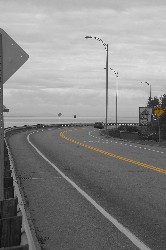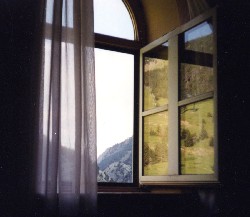Stefan's photography: Typical post-processing workflow
The following outlines the way I process my photographs.
Documentation about photography post-processing abounds—in
particular GimpGuru.org's
tutorials are very useful—so I am only giving an
outline; if you want to know details just contact
me and I would be more than happy to ellaborate.
I normally shoot RAW, and I revert to maximum-quality JPEG only
when memory card space becomes an issue (or when using the SD700
which produces only JPEGs). The workflow I outline below is the
one for RAW photographs; JPEG photographs are first converted to
24-bit PNG images and then follow the same workflow (except that
the first item is skipped).
- I first use Dave Coffin's dcraw in
16-bit mode (-4), with the camera's white ballance
(-w), with this EOS 10D
linear profile (-p), and with highlight
reconstruction (-H 2). The result goes
into pnmtopng (part of netpbm) and this gets
me the 48-bit master PNG.
- True, at the end of the day I end up with a 24-bit
image, but the 48-bit output of dcraw is much better that its
24-bit output and I also attempt to keep the processing at the
48-bit level for as long as possible (which is not much right
now, but I expect that the Gimp will be able to handle 48-bit
images in the near future).
- At the same time I use exiftool to
extract the original EXIF which is stored along with the
photograph.
- I then load the master PNG into my digital darkroom, The Gimp. I process the
photograph doing as few of the following steps as possible.
- Layer->Colors->Levels: I adjust the levels and
midtones to improve dynamic range.
- Layer->Colors->Curves: I set the typical three
control points and adjust the curves to increase contrast
and brightness; I play around with the three points until
the image looks right.
- I increase colour saturation as needed using Vivid
Saturation included in the Photokit GIMP
plugins (often an increase of 6 will do nicely).
- Out of the box alternative is
Layer->Colors->Hue-Saturation (increasing
saturation by 15-20% is often appropriate).
- I use the curves again and play around with different
colors and the center control point to white balance the
image.
- The white point is corrected if necessary using the
color-wb-balance.scm
script.
- The Adaptive Contrast Enhancement
(Filters->Colors->Adaptive Contrast) is also useful now
and then.
- I apply as needed specific effects such as blur
overlay, ND
filter, and contrast
mask.
- I then apply a smart
USM sharpening using the Smart Sharpen
(Redux) plugin (good starting point parameters are USM
amount 2, USM radius 1, USM threshold 0, edge detect amount
6, and edge blur 7).
- Out of the box alternative is
Filters->Enhance->Unsharp Mask.
- In the process the image is converted to 24-bit depth, which
results in a 6 to 12 MB PNG. I find this as the best compromise
between size, quality, and convenience, so this is the end
result of the post-processing. Since few tools support EXIF
retrieval fron PNG images the EXIF information is kept as plain
text and integrated into the albums by a modified version of flPhoto.
Film photography
I no longer do film photography, so this comment is pertinent
only to old photographs and old negatives. For these I use an Epson
Perfection 1660 Photo scanner driven by SANE. I started doing
scans at 350 dpi but then I increased the resolution (so that
you might see scans anywhere between 350 and 500 dpi).
I then put the result through the same workflow as above (and as
needed).
Unfortunately the medium I scanned some—mostly
older—photographs from was in a very bad condition, so you
may see specks of dust and other artifacts in there (in some cases
these artifacts rendered the photographs impossible to
post-process).
[Stefan's photography]
[Stefan's home page]
stefan@bruda.ca
Last modified: Thu May 10 23:49:57 EDT 2012



